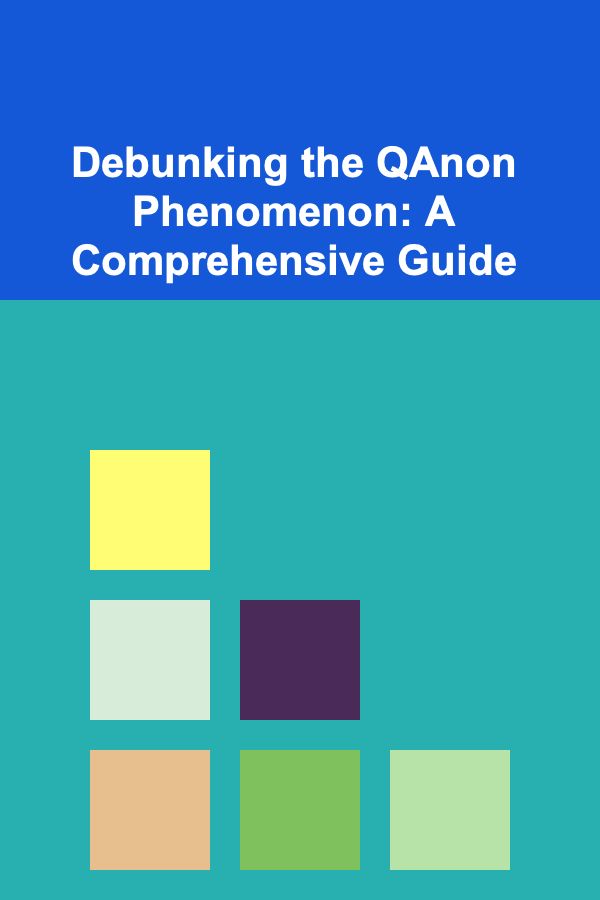
Debunking the QAnon Phenomenon: A Comprehensive Guide
ebook include PDF & Audio bundle (Micro Guide)
$12.99$5.99
Limited Time Offer! Order within the next:

QAnon is a far-right conspiracy theory detailing a supposed secret plot against former U.S. President Donald Trump by a "deep state" composed of Satan-worshipping pedophiles. Originating in late 2017, QAnon has evolved from obscure internet forums to a significant force in mainstream political discourse, influencing elections, inspiring acts of violence, and deeply impacting personal relationships.
Debunking QAnon requires a multifaceted approach that combines critical thinking, media literacy, psychological understanding, and empathetic communication. This guide offers a comprehensive framework for understanding the core tenets of QAnon, analyzing its spread and appeal, and providing strategies for effectively challenging its narratives.
Understanding QAnon: Core Beliefs and Origins
To effectively debunk QAnon, it's crucial to understand its central claims and how they have evolved over time. Key elements of the QAnon conspiracy theory include:
- The Deep State: A shadowy cabal of government officials, celebrities, and business leaders who are secretly working to undermine Trump and conservative values.
- Satanic Ritual Abuse: A baseless accusation that the Deep State is involved in widespread child sex trafficking and ritualistic abuse. This draws heavily on the discredited "Satanic Panic" of the 1980s and 90s.
- The Storm: A prophesied day of reckoning when Trump will arrest and prosecute the Deep State, leading to a period of global peace and prosperity.
- "The Great Awakening": The idea that QAnon followers are helping to wake up the rest of the world to the truth about the Deep State.
- Breadcrumbs: Supposed cryptic messages ("Q drops") left by a high-ranking government insider ("Q") that provide clues to the Deep State's plans. These are often vague and open to interpretation, allowing followers to fit them to existing narratives.
QAnon originated on the anonymous imageboard 4chan and quickly spread to other online platforms like 8chan (later 8kun), Reddit, Facebook, and YouTube. The anonymity of these platforms, combined with algorithms that prioritize engagement, allowed QAnon narratives to flourish and reach a wider audience.
The Role of "Q"
The identity of "Q" remains unknown. While various theories have been proposed, no definitive evidence has emerged. "Q's" vague pronouncements are frequently interpreted and amplified by a network of influencers and online communities. This ambiguity allows for a continuous reinterpretation of "Q drops" to fit evolving events and personal beliefs, making the conspiracy theory incredibly resilient.
Analyzing the Appeal of QAnon
Understanding why people are drawn to QAnon is essential for effective debunking. Several factors contribute to its appeal:
- Simplified Explanations: QAnon provides a seemingly simple explanation for complex world events, offering a sense of control and understanding in a chaotic world. It provides a comforting narrative of good versus evil, with clear heroes and villains.
- Sense of Community: QAnon fosters a strong sense of community among its followers. They feel connected to others who share their beliefs and are working towards a common goal. This sense of belonging can be particularly appealing to individuals who feel isolated or marginalized.
- Empowerment: QAnon empowers followers by making them feel like they are part of a secret movement that is fighting against powerful forces. They believe they are "doing their research" and uncovering hidden truths that others are blind to.
- Distrust of Authority: QAnon taps into a growing distrust of mainstream media, government institutions, and experts. This distrust is fueled by political polarization, social inequality, and perceived corruption.
- Cognitive Biases: QAnon narratives exploit several cognitive biases, including confirmation bias (seeking out information that confirms existing beliefs), illusory correlation (perceiving relationships between unrelated events), and the backfire effect (strengthening beliefs when presented with contradictory evidence).
- Hope and Optimism: Despite the often-dark nature of the conspiracy, QAnon offers a hopeful vision of the future, where the Deep State is defeated and the world is a better place. This hope can be particularly appealing to individuals who are struggling with feelings of anxiety, fear, or hopelessness.
Debunking Strategies: A Practical Guide
Debunking QAnon is a challenging but necessary task. Here are several strategies that can be employed:
1. Lead with Empathy and Understanding
Approaching someone who believes in QAnon with hostility or condescension is unlikely to be effective. Instead, try to understand their motivations and concerns. Start by listening to their perspective and asking open-ended questions.
"I'm curious, what is it about QAnon that resonates with you?"
Avoid accusatory language and try to find common ground. Acknowledge their concerns about the world and validate their desire to make a difference. Remember that people are often drawn to QAnon because they are looking for answers, community, and a sense of purpose.
2. Focus on Critical Thinking and Media Literacy
One of the most effective ways to debunk QAnon is to help people develop critical thinking skills and media literacy. Teach them how to:
- Evaluate sources: Encourage them to question the credibility and reliability of the information they are consuming. Ask them to consider the source's bias, funding, and reputation.
- Identify logical fallacies: Help them recognize common logical fallacies, such as ad hominem attacks, straw man arguments, and appeals to emotion. QAnon narratives are often riddled with these fallacies.
- Distinguish between fact and opinion: Teach them to differentiate between verifiable facts and subjective opinions. Encourage them to look for evidence to support claims.
- Consider alternative explanations: Encourage them to consider alternative explanations for events and to avoid jumping to conclusions. QAnon often presents a single, conspiratorial explanation for complex phenomena.
- Reverse Image Search: Teach them how to use reverse image search tools (like Google Images) to verify the authenticity of images and videos shared within QAnon communities. Often, these images are manipulated or taken out of context.
Direct them to resources that promote critical thinking and media literacy, such as:
- Fact-checking websites: Snopes, PolitiFact, FactCheck.org
- Media literacy organizations: The News Literacy Project, MediaSmarts
- Academic research on misinformation and disinformation.
3. Highlight Inconsistencies and Failed Predictions
QAnon is notorious for its failed predictions. "The Storm" has been repeatedly predicted and postponed, and many of Q's pronouncements have been proven false. Pointing out these inconsistencies can help to erode trust in the conspiracy theory.
Keep a record of QAnon predictions that have not come true. Present this information in a clear and factual manner, without being condescending or judgmental.
Example: "Q predicted that Hillary Clinton would be arrested on [date]. That didn't happen. How do you reconcile that with the belief that Q is a reliable source of information?"
4. Challenge the Underlying Logic and Assumptions
QAnon is built on a series of logical fallacies and unsubstantiated assumptions. Challenging these assumptions can help to dismantle the entire conspiracy theory.
For example, QAnon often claims that a group of powerful elites are secretly controlling the world. Ask them:
- "What evidence do you have to support this claim?"
- "Is it really plausible that such a large group of people could keep such a massive secret?"
- "What would be their motivation for doing this?"
By questioning the underlying logic and assumptions of QAnon, you can help people to see the flaws in its reasoning.
5. Debunk Specific Claims with Evidence-Based Information
When addressing specific QAnon claims, provide accurate and evidence-based information to counter the misinformation. Use credible sources such as scientific studies, government reports, and reputable news organizations.
For example, if someone claims that vaccines cause autism, provide them with information from the Centers for Disease Control and Prevention (CDC) and the World Health Organization (WHO) that debunks this myth.
Be prepared to address counterarguments and to provide further evidence to support your claims. It's important to be patient and persistent, as changing someone's mind can take time.
6. Focus on the Real-World Harm of QAnon
QAnon has had real-world consequences, including:
- Political violence: QAnon has inspired acts of violence, including the January 6th attack on the U.S. Capitol.
- Family divisions: QAnon has caused rifts within families and friendships, as people become increasingly entrenched in their beliefs.
- Mental health problems: QAnon can contribute to anxiety, paranoia, and other mental health problems.
- Erosion of trust in institutions: QAnon undermines trust in government, media, and other institutions, making it harder to address societal problems.
Highlighting these real-world harms can help people to see the dangers of QAnon and to question its underlying premises.
7. Acknowledge Uncertainty and Complexity
It's important to acknowledge that the world is complex and that there are often no easy answers. QAnon offers a simplistic and comforting narrative, but it's ultimately based on falsehoods and misinformation.
Encourage people to embrace uncertainty and to be comfortable with not knowing everything. Promote the idea that it's okay to change your mind when presented with new evidence.
8. Support Individuals Seeking to Leave QAnon
Leaving QAnon can be a difficult and painful process. People who are trying to leave may experience feelings of guilt, shame, and isolation.
Provide support and understanding to individuals who are seeking to leave QAnon. Connect them with resources that can help them to deprogram and to rebuild their lives.
Resources include:
- Support groups for former QAnon followers.
- Mental health professionals who specialize in cult deprogramming.
- Organizations that provide support to families affected by QAnon.
9. Protect Yourself and Others Online
Engaging with QAnon online can be risky. Be mindful of the following:
- Avoid engaging in personal attacks or insults. This will only escalate the situation and make it harder to reach the person.
- Protect your personal information. Be careful about sharing personal information online, as QAnon followers may attempt to dox or harass you.
- Report QAnon content to social media platforms. Most social media platforms have policies against hate speech and misinformation.
- Set boundaries. It's okay to disengage from conversations that are becoming too heated or draining.
Challenges and Considerations
Debunking QAnon presents several challenges:
- The Backfire Effect: Presenting facts that contradict a QAnon believer's worldview may inadvertently strengthen their conviction. Careful framing and empathetic communication are crucial.
- Entrenched Beliefs: Individuals deeply invested in QAnon may be resistant to change, especially if their social network is heavily influenced by the conspiracy theory.
- The Hydra Effect: When one QAnon conspiracy is debunked, others often emerge to take its place. Addressing the underlying vulnerabilities that lead to conspiratorial thinking is essential.
- The Anonymity of the Internet: The anonymity afforded by online platforms allows QAnon narratives to spread rapidly and unchecked.
Despite these challenges, it is crucial to persist in debunking QAnon. The stakes are high, and the consequences of inaction are significant.
Conclusion
Debunking the QAnon phenomenon requires a multifaceted approach that combines critical thinking, media literacy, psychological understanding, and empathetic communication. By understanding the core tenets of QAnon, analyzing its appeal, and employing effective debunking strategies, we can help to mitigate its harmful effects and to promote a more informed and rational society.
This is not a quick fix. It's a long-term process that requires patience, persistence, and a commitment to truth and reason. By working together, we can help to dismantle the QAnon conspiracy theory and to build a more resilient and informed world.

Affordable Gift Ideas for Friends and Family That They'll Love
Read More
How to Choose the Best International Shipping Options Based on Your Target Markets
Read More
How to Keep Your Home Party Organized with a Party Timeline
Read More
How to Use the Envelope System for Effective Budgeting
Read More
How to Use Blockchain for Real Estate Transactions
Read More
How To Give Constructive Feedback Effectively
Read MoreOther Products

Affordable Gift Ideas for Friends and Family That They'll Love
Read More
How to Choose the Best International Shipping Options Based on Your Target Markets
Read More
How to Keep Your Home Party Organized with a Party Timeline
Read More
How to Use the Envelope System for Effective Budgeting
Read More
How to Use Blockchain for Real Estate Transactions
Read More